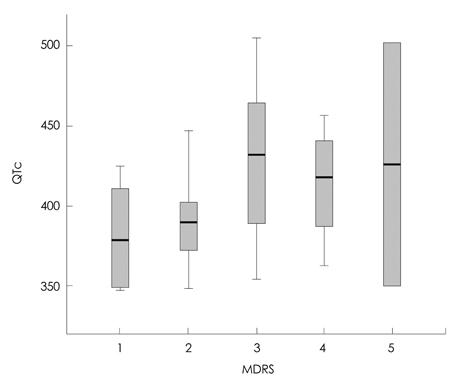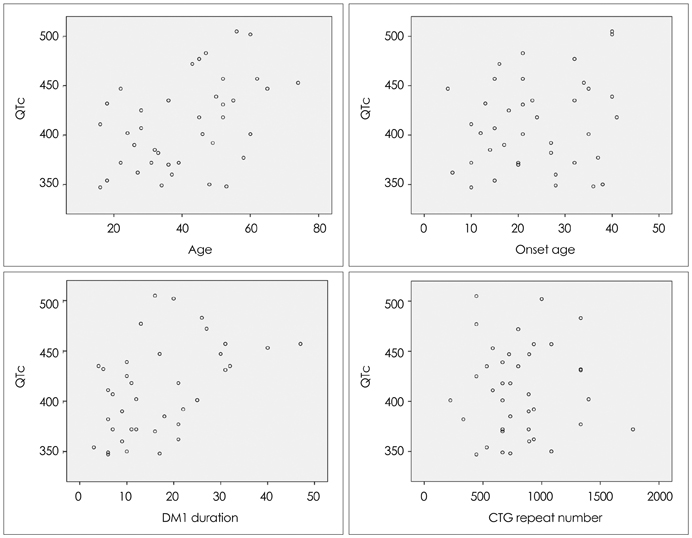J Clin Neurol.
2013 Jul;9(3):186-191. 10.3988/jcn.2013.9.3.186.
Prolonged Corrected QT Interval in Patients with Myotonic Dystrophy Type 1
- Affiliations
-
- 1Department of Neurology, Haeundae Paik Hospital, Inje University, Busan, Korea. neurof@naver.com
- 2Department of Neurology, Sungkyunkwan University School of Medicine, Seoul, Korea.
- KMID: 2287557
- DOI: http://doi.org/10.3988/jcn.2013.9.3.186
Abstract
- BACKGROUND AND PURPOSE
Sudden cardiac death is one of the leading causes of death in patients with myotonic dystrophy type 1 (DM1). It has been proposed that a prolonged QT interval is associated with sudden cardiac death in several neurological diseases, including multiple system atrophy, idiopathic Parkinson's disease, and diabetic autonomic neuropathy. However, analyses of the corrected QT (QTc) interval in DM1 patients are rare in the literature. The purposes of this study were to determine the association between the QT interval and DM1, and the affecting factors.
METHODS
Thirty-nine patients diagnosed with DM1 through genetic testing were enrolled. The QTc interval (calculated using Bazett's formula: QTc=QT/radicalRR) was compared between these patients and 39 normal healthy controls. The clinical and laboratory factors affecting QTc interval in the patient group were investigated.
RESULTS
The QTc interval was significantly longer in the DM1 group (411.2+/-44.7 msec, mean+/-SD) than in the normal control group (355.6+/-20.6 msec). Intragroup analysis revealed that a prolonged QTc interval in DM1 patients was associated with being female and older, having a longer disease duration, and exhibiting abnormal electrocardiography findings.
CONCLUSIONS
The higher incidence of sudden cardiac death in the DM1 population is associated with the observed prolonged QTc interval in those patients.
MeSH Terms
Figure
Reference
-
1. Gharehbaghi-Schnell EB, Finsterer J, Korschineck I, Mamoli B, Binder BR. Genotype-phenotype correlation in myotonic dystrophy. Clin Genet. 1998; 53:20–26.
Article2. Pizzuti A, Friedman DL, Caskey CT. The myotonic dystrophy gene. Arch Neurol. 1993; 50:1173–1179.
Article3. Jaspert A, Fahsold R, Grehl H, Claus D. Myotonic dystrophy: correlation of clinical symptoms with the size of the CTG trinucleotide repeat. J Neurol. 1995; 242:99–104.
Article4. Mondelli M, Rossi A, Malandrini A, Della Porta P, Guzaai GC. Axonal motor and sensory neuropathy in myotonic dystrophy. Acta Neurol Scand. 1993; 88:141–148.
Article5. Meola G. Clinical and genetic heterogeneity in myotonic dystrophies. Muscle Nerve. 2000; 23:1789–1799.
Article6. Harley HG, Brook JD, Rundle SA, Crow S, Reardon W, Buckler AJ, et al. Expansion of an unstable DNA region and phenotypic variation in myotonic dystrophy. Nature. 1992; 355:545–546.
Article7. Aslanidis C, Jansen G, Amemiya C, Shutler G, Mahadevan M, Tsilfidis C, et al. Cloning of the essential myotonic dystrophy region and mapping of the putative defect. Nature. 1992; 355:548–551.
Article8. Harley HG, Rundle SA, MacMillan JC, Myring J, Brook JD, Crow S, et al. Size of the unstable CTG repeat sequence in relation to phenotype and parental transmission in myotonic dystrophy. Am J Hum Genet. 1993; 52:1164–1174.9. Ashizawa T, Dunne CJ, Dubel JR, Perryman MB, Epstein HF, Boerwinkle E, et al. Anticipation in myotonic dystrophy. I. Statistical verification based on clinical and haplotype findings. Neurology. 1992; 42:1871–1877.
Article10. Melacini P, Villanova C, Menegazzo E, Novelli G, Danieli G, Rizzoli G, et al. Correlation between cardiac involvement and CTG trinucleotide repeat length in myotonic dystrophy. J Am Coll Cardiol. 1995; 25:239–245.
Article11. Tokgozoglu LS, Ashizawa T, Pacifico A, Armstrong RM, Epstein HF, Zoghbi WA. Cardiac involvement in a large kindred with myotonic dystrophy. Quantitative assessment and relation to size of CTG repeat expansion. JAMA. 1995; 274:813–819.
Article12. Finsterer J, Gharehbaghi-Schnell E, Stöllberger C, Fheodoroff K, Seiser A. Relation of cardiac abnormalities and CTG-repeat size in myotonic dystrophy. Clin Genet. 2001; 59:350–355.
Article13. Sabovic M, Medica I, Logar N, Mandić E, Zidar J, Peterlin B. Relation of CTG expansion and clinical variables to electrocardiogram conduction abnormalities and sudden death in patients with myotonic dystrophy. Neuromuscul Disord. 2003; 13:822–826.
Article14. Pelargonio G, Dello Russo A, Sanna T, De Martino G, Bellocci F. Myotonic dystrophy and the heart. Heart. 2002; 88:665–670.
Article15. Mathieu J, Allard P, Potvin L, Prévost C, Bégin P. A 10-year study of mortality in a cohort of patients with myotonic dystrophy. Neurology. 1999; 52:1658–1662.
Article16. Glickstein JS, Schwartzman D, Friedman D, Rutkowski M, Axelrod FB. Abnormalities of the corrected QT interval in familial dysautonomia: an indicator of autonomic dysfunction. J Pediatr. 1993; 122:925–928.
Article17. Lo SS, Mathias CJ, Sutton MS. QT interval and dispersion in primary autonomic failure. Heart. 1996; 75:498–501.
Article18. Deguchi K, Sasaki I, Tsukaguchi M, Kamoda M, Touge T, Takeuchi H, et al. Abnormalities of rate-corrected QT intervals in Parkinson's disease-a comparison with multiple system atrophy and progressive supranuclear palsy. J Neurol Sci. 2002; 199:31–37.
Article19. Breton R, Mathieu J. Usefulness of clinical and electrocardiographic data for predicting adverse cardiac events in patients with myotonic dystrophy. Can J Cardiol. 2009; 25:e23–e27.
Article20. Groh WJ, Groh MR, Saha C, Kincaid JC, Simmons Z, Ciafaloni E, et al. Electrocardiographic abnormalities and sudden death in myotonic dystrophy type 1. N Engl J Med. 2008; 358:2688–2697.
Article21. Magrì D, Piccirillo G, Bucci E, Pignatelli G, Cauti FM, Morino S, et al. Increased temporal dispersion of myocardial repolarization in myotonic dystrophy type 1: beyond the cardiac conduction system. Int J Cardiol. 2012; 156:259–264.
Article22. Mathieu J, De Braekeleer M, Prévost C, Boily C. Myotonic dystrophy: clinical assessment of muscular disability in an isolated population with presumed homogeneous mutation. Neurology. 1992; 42:203–208.23. Hannan PJ, Crow RS. Concerning the units for the QT interval corrected by Bazett's formula. Circulation. 1997; 96:3799.24. Melacini P, Buja G, Fasoli G, Angelini C, Armani M, Scognamiglio R, et al. The natural history of cardiac involvement in myotonic dystrophy: an eight-year follow-up in 17 patients. Clin Cardiol. 1988; 11:231–238.
Article25. Hayashi Y, Ikeda U, Kojo T, Nishinaga M, Miyashita H, Kuroda T, et al. Cardiac abnormalities and cytosine-thymine-guanine trinucleotide repeats in myotonic dystrophy. Am Heart J. 1997; 134(2 Pt 1):292–297.
Article26. Diedrich A, Jordan J, Shannon JR, Robertson D, Biaggioni I. Modulation of QT interval during autonomic nervous system blockade in humans. Circulation. 2002; 106:2238–2243.
Article27. Di Leo R, Rodolico C, De Gregorio C, Recupero A, Coglitore S, Annesi G, et al. Cardiovascular autonomic control in myotonic dystrophy type 1: a correlative study with clinical and genetic data. Neuromuscul Disord. 2004; 14:136–141.
Article28. Olofsson BO, Niklasson U, Forsberg H, Bjerle P, Andersson S, Henriksson A. Assessment of autonomic nerve function in myotonic dystrophy. J Auton Nerv Syst. 1990; 29:187–192.
Article29. Pierangeli G, Lugaresi A, Contin M, Martinelli P, Montagna P, Parchi P, et al. Autonomic nervous system function in myotonic dystrophy. Ital J Neurol Sci. 1992; 13:589–592.
Article30. Inoue K, Ogata H, Matsui M, Hayano J, Miyake S, Kumashiro M, et al. Assessment of autonomic function in myotonic dystrophy by spectral analysis of heart-rate variability. J Auton Nerv Syst. 1995; 55:131–134.
Article31. Rana BS, Band MM, Ogston S, Morris AD, Pringle SD, Struthers AD. Relation of QT interval dispersion to the number of different cardiac abnormalities in diabetes mellitus. Am J Cardiol. 2002; 90:483–487.
Article32. Behr E, Wood DA, Wright M, Syrris P, Sheppard MN, Casey A, et al. Cardiological assessment of first-degree relatives in sudden arrhythmic death syndrome. Lancet. 2003; 362:1457–1459.
Article33. Rautaharju PM, Nelson JC, Kronmal RA, Zhang ZM, Robbins J, Gottdiener JS, et al. Usefulness of T-axis deviation as an independent risk indicator for incident cardiac events in older men and women free from coronary heart disease (the Cardiovascular Health Study). Am J Cardiol. 2001; 88:118–123.
Article34. Phillips MF, Harper PS. Cardiac disease in myotonic dystrophy. Cardiovasc Res. 1997; 33:13–22.
Article35. Bhakta D, Lowe MR, Groh WJ. Prevalence of structural cardiac abnormalities in patients with myotonic dystrophy type I. Am Heart J. 2004; 147:224–227.
Article
- Full Text Links
- Actions
-
Cited
- CITED
-
- Close
- Share
- Similar articles
-
- A Case of Myotonic Dystrophy with Prolonged Atrial Flutter
- Myotonic Dystrophy Type 1 With Brain MRI Lesions Involving White Matters in Anterior Temporal Pole and Insula
- Radiofrequency Catheter Ablation of Persistent Atrial Fibrillation with Myotonic Dystrophy and Achalasia-like Esophageal Dilatation
- Accidentally Diagnosed Myotonic Dystrophy after Cholecystectomy
- A Case of Congenital Myotonic Dystrophy Diagnosed by Molecular Genetics



